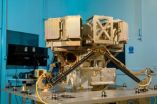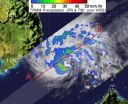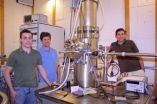(Press-News.org) Imagine being able to use electricity to power your car — even if it's not an electric vehicle. Researchers at the UCLA Henry Samueli School of Engineering and Applied Science have for the first time demonstrated a method for converting carbon dioxide into liquid fuel isobutanol using electricity.
Today, electrical energy generated by various methods is still difficult to store efficiently. Chemical batteries, hydraulic pumping and water splitting suffer from low energy-density storage or incompatibility with current transportation infrastructure.
In a study published March 30 in the journal Science, James Liao, UCLA's Ralph M. Parsons Foundation Chair in Chemical Engineering, and his team report a method for storing electrical energy as chemical energy in higher alcohols, which can be used as liquid transportation fuels.
"The current way to store electricity is with lithium ion batteries, in which the density is low, but when you store it in liquid fuel, the density could actually be very high," Liao said. "In addition, we have the potential to use electricity as transportation fuel without needing to change current infrastructure."
Liao and his team genetically engineered a lithoautotrophic microorganism known as Ralstonia eutropha H16 to produce isobutanol and 3-methyl-1-butanol in an electro-bioreactor using carbon dioxide as the sole carbon source and electricity as the sole energy input.
Photosynthesis is the process of converting light energy to chemical energy and storing it in the bonds of sugar. There are two parts to photosynthesis — a light reaction and a dark reaction. The light reaction converts light energy to chemical energy and must take place in the light. The dark reaction, which converts CO2 to sugar, doesn't directly need light to occur.
"We've been able to separate the light reaction from the dark reaction and instead of using biological photosynthesis, we are using solar panels to convert the sunlight to electrical energy, then to a chemical intermediate, and using that to power carbon dioxide fixation to produce the fuel," Liao said. "This method could be more efficient than the biological system."
Liao explained that with biological systems, the plants used require large areas of agricultural land. However, because Liao's method does not require the light and dark reactions to take place together, solar panels, for example, can be built in the desert or on rooftops.
Theoretically, the hydrogen generated by solar electricity can drive CO2 conversion in lithoautotrophic microorganisms engineered to synthesize high-energy density liquid fuels. But the low solubility, low mass-transfer rate and the safety issues surrounding hydrogen limit the efficiency and scalability of such processes. Instead Liao's team found formic acid to be a favorable substitute and efficient energy carrier.
"Instead of using hydrogen, we use formic acid as the intermediary," Liao said. "We use electricity to generate formic acid and then use the formic acid to power the CO2 fixation in bacteria in the dark to produce isobutanol and higher alcohols."
The electrochemical formate production and the biological CO2 fixation and higher alcohol synthesis now open up the possibility of electricity-driven bioconversion of CO2 to a variety of chemicals. In addition, the transformation of formate into liquid fuel will also play an important role in the biomass refinery process, according to Liao.
"We've demonstrated the principle, and now we think we can scale up," he said. "That's our next step."
INFORMATION:
The study was funded by a grant from the U.S. Department of Energy's Advanced Research Projects Agency–Energy (ARPA–E).
The UCLA Henry Samueli School of Engineering and Applied Science, established in 1945, offers 28 academic and professional degree programs and has an enrollment of more than 5,000 students. The school's distinguished faculty are leading research to address many of the critical challenges of the 21st century, including renewable energy, clean water, health care, wireless sensing and networking, and cybersecurity. Ranked among the top 10 engineering schools at public universities nationwide, the school is home to nine multimillion-dollar interdisciplinary research centers in wireless sensor systems, nanoelectronics, nanomedicine, renewable energy, customized computing, and the smart grid, all funded by federal and private agencies.
For more UCLA news, visit the UCLA Newsroom and follow us on Twitter.
END
PITTSBURGH—Sooner than later, robots may have the ability to "feel." In a paper published online March 26 in Advanced Functional Materials, a team of researchers from the University of Pittsburgh and the Massachusetts Institute of Technology (MIT) demonstrated that a nonoscillating gel can be resuscitated in a fashion similar to a medical cardiopulmonary resuscitation. These findings pave the way for the development of a wide range of new applications that sense mechanical stimuli and respond chemically—a natural phenomenon few materials have been able to mimic.
A team ...
A short new video takes viewers behind the scenes with the MIRI or the Mid-Infrared Instrument that will fly on-board NASA's James Webb Space Telescope. MIRI is a state-of-the-art infrared instrument that will allow scientists to study distant objects in greater detail than ever before.
The three minute and 19 second video called "The MIRI Has Two Faces" is part of an on-going video series about the Webb telescope called "Behind the Webb." It was produced at the Space Telescope Science Institute (STScI) in Baltimore, Md. and takes viewers behind the scenes with scientists ...
System 96W intensified overnight and became Tropical Storm Pakhar during the morning hours on March 29. NASA's TRMM satellite measured rainfall rates within the storm, and noticed areas of heavy rain west of the center as the storm continued to strengthen.
NASA's Tropical Rainfall Measuring Mission (TRMM) satellite passed over Pakhar on March 29, and saw that it was generating mostly light to moderate rainfall around the entire system, with areas of heavy rain in the southwestern and northeastern quadrants. Light to moderate rainfall rates were between .78 to 1.57 inches ...
RealCapitalMarkets.com, LLC (RCM1), the leading provider of a leading provider of marketing and transaction management software for commercial property and note sales, announces updates to the RCM1 platform designed to allow clients to synchronize buyer data with their internal customer relationship management (CRM) systems, speed up execution of key functionality such as uploading and downloading documents, and provide additional time-saving features to clients and investors.
"This latest update streamlines many of the daily tasks our clients rely on so they can ...
Asian Canadian teenagers who identify as lesbian, gay or bisexual are 30 times more likely to face harassment than their heterosexual peers – a factor that is linked to higher rates of alcohol or drug use, according to University of British Columbia research.
Recently published in the Canadian Journal of Community Mental Health, this is the first study in North America to investigate the links between Asian teens dealing with "dual minority discrimination," problem substance use and supports that can help reduce those risks.
"Discrimination for both ethnicity and sexual ...
WHAT:
Mosquitoes infected with dengue virus experience an array of changes in the activity of genes and associated functions of their salivary glands, and these changes may lead to increased virus transmission, according to a recent study led by George Dimopoulos, Ph.D., of the Malaria Research Institute and Bloomberg School of Public Health at Johns Hopkins University. Some of these changes involve the mosquito's immune system and affect its susceptibility to infection with the virus. Others involve factors that enhance the mosquito's capacity to feed on blood, possibly ...
Boulder, Colorado, USA – The April/May GSA Today science article is now online at www.geosociety.org/gsatoday/. In this issue, Simon Williams and colleagues from the Earthbyte Group of the School of Geosciences at the University of Sydney present GPlates, a powerful new method for analyzing geological and geophysical data sets within the context of tectonic reconstructions.
GPlates is part of a new generation of plate reconstruction software that incorporates functionality familiar from GIS software with the added dimension of geological time. By enabling the user to ...
Graphite, more commonly known as pencil lead, could become the next big thing in the quest for smaller and less power-hungry electronics.
Resembling chicken wire on a nano scale, graphene – single sheets of graphite – is only one atom thick, making it the world's thinnest material. Two million graphene sheets stacked up would not be as thick as a credit card.
The tricky part physicists have yet to figure out how to control the flow of electrons through the material, a necessary prerequisite for putting it to work in any type of electronic circuit. Graphene behaves very ...
Amsterdam, NL -- Investigators from the University of Amsterdam, Netherlands, have shown that in most elderly patients invasive and expensive techniques, i.e. lumbar puncture and PET scan, are not useful to establish the diagnosis of Alzheimer's disease. They arrived at this conclusion after analysis of data from the Alzheimer's Disease Neuroimaging Initiative (ADNI), a large collaborative research project of medical centers in the USA and Canada.
The Dutch researchers divided the ADNI sample into two halves, a younger (74 y). They showed that the CSF biomarkers (amyloid ...
London -- New strategies injecting cardiovascular disease (CVD) patients with vaccines and monoclonal antibodies to combat atherosclerosis could soon change the treatment landscape of heart disease. Both approaches, Professor Jan Nilsson told delegates at the Frontiers in CardioVascular Biology (FCVB) 2012 meeting, can be considered truly ground breaking since for the first time they target the underlying cause of CVD. The FCVB meeting, organised by the Council on Basic Cardiovascular Science (CBCS) of the European Society of Cardiology (ESC), held 30 March to 1 April at ...


